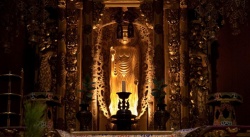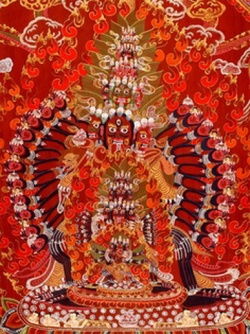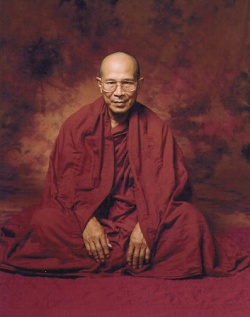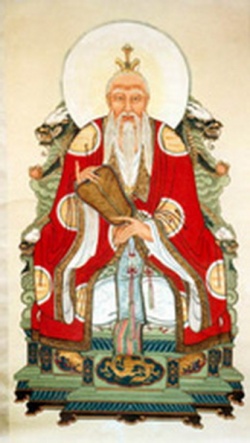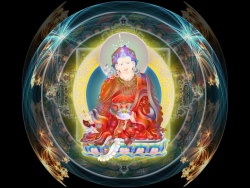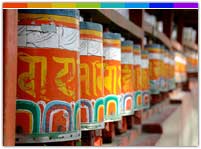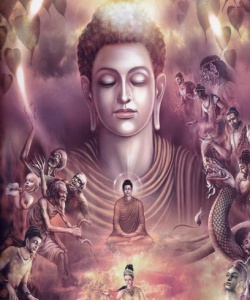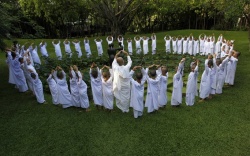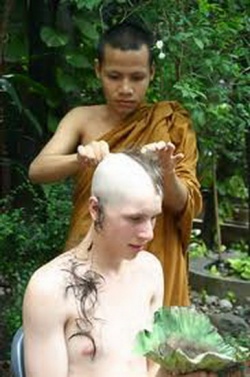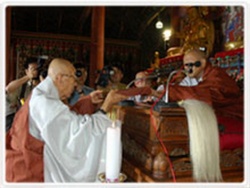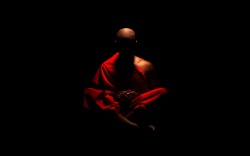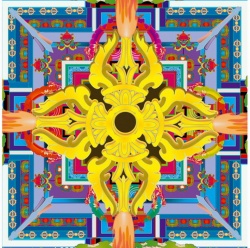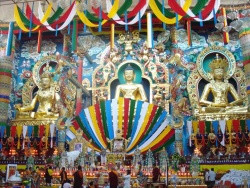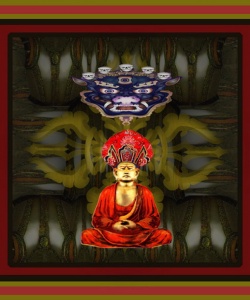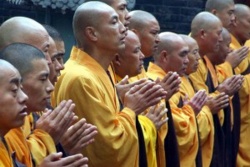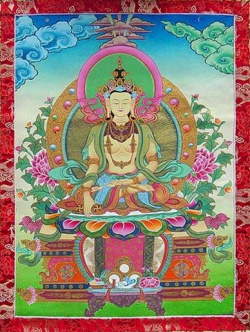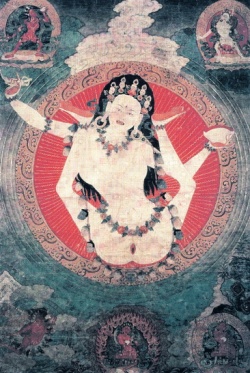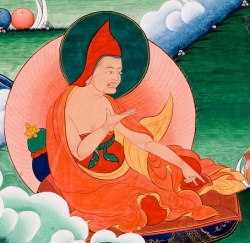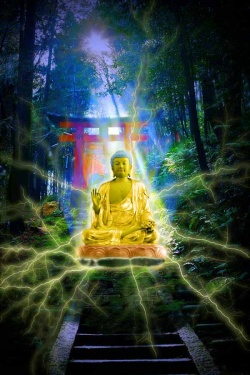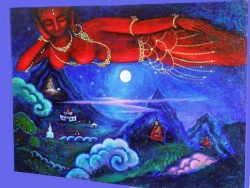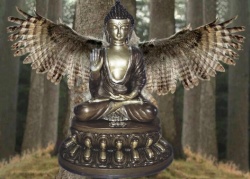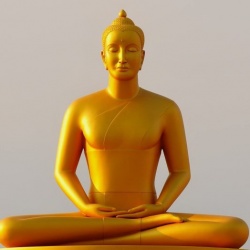Difference between revisions of "Lineage in Gong Chik"
m (Text replacement - "sugar" to "sugar") |
|||
| Line 56: | Line 56: | ||
| − | So now we will discuss [[chapter]] six of the [[Gong Chik]]. I will give a brief [[life]] story of [[Jigten Sumgon]]. He was born in [[Eastern Tibet]]. It is said he had a [[compassionate]] [[nature]]. In [[Tibet]] | + | So now we will discuss [[chapter]] six of the [[Gong Chik]]. I will give a brief [[life]] story of [[Jigten Sumgon]]. He was born in [[Eastern Tibet]]. It is said he had a [[compassionate]] [[nature]]. In [[Tibet]] sugar is difficult to get. |
He once got some and was going to eat it, but saw a {{Wiki|beggar}} and gave it to him instead. He went through many difficulties, {{Wiki|poverty}} and losing his [[parents]]. When he heard the [[name]] [[Phagmodrupa]] he felt profound [[devotion]] and went to study with him. | He once got some and was going to eat it, but saw a {{Wiki|beggar}} and gave it to him instead. He went through many difficulties, {{Wiki|poverty}} and losing his [[parents]]. When he heard the [[name]] [[Phagmodrupa]] he felt profound [[devotion]] and went to study with him. | ||
Revision as of 06:06, 4 February 2016
We need the protection of the dharma, because there are so many obstacles to practice. Most of our obstacles come from our friends and not enemies. The advice our friends give seems helpful, but actually harms us. This is called the Devaputra Mara. Mara lives in the highest god realm in the desire realm. He doesn't like anyone to get higher than he does.
When Buddha sat in Bodhgaya, he went to him and told him that his brother was making a mess of things in his kingdom. We also have the obstacles of not enough time and being too tired to practice. So obstacles never come from enemies, but from friends.
To dispel obstacles, we can meditate on bodhicitta, or recite mantras. In tantra there are many protection practices. It sometimes seems that good practitioners have more problems.
If there is one text you can get liberated by, it would be the Heart Sutra. I'm not saying you can get liberated just by emptiness, but the Heart Sutra contains the main teaching.
For anything we do, we need the proper motivation. The mind controls body and speech. And the mind is controlled by motivation. If someone becomes a Buddhist and take refuge, they need renunciation. Refuge is part of Vinaya. It is said if you have renunciation, you take the Vinaya vow. You must cut the attachment to this life.
But this does mean you shouldn't take care of yourself or be kind to others. After that you take the bodhisattva vows, and the motivation changes to helping sentient beings, who have been your kind mothers. Our motivation changes to bodhicitta, to free beings from suffering. And when we practice tantra, our motivation changes to the five certainties: of the Sambhogakaya.
These are first, the certainty of place, that this world is Akanishta. Second, the certainty of body, that it is the form of Buddha, adorned with the major and minor marks.
Third, the certainty of time, that one will live as long as samsara is not empty. Fourth, the certainty of teachings, that one will always teach the Mahayana. And fifth, the certainty of disciples, that they all are bodhisattvas.
Deity yoga has three main points: pride, purity, and clarity. Pride is seeing yourself as the deity. We all have buddha nature. Our natures are not different, only the amount of confusion. False pride is to think that you are the best. Divine pride is to see yourself as inseparable from the yidam deity. One causes you to be born in samsara, the other leads to enlightenment. The next is purity. We visualize the place we practice as a pure land.
Clarity is visualizing the image of the Buddha clearly. But the most important point is divine pride. The next point is conduct. I usually set up two thrones, but Khenchen didn't like that. It's said you shouldn't sit on your lama's throne.
The throne is respect for the teaching and not the the teacher. You sit higher because the message is important. Buddha never said that you have to do this because he said so. He determined the nature of reality and taught it to us. You shouldn't recite mantras while listening to a teaching. That's not showing respect for the dharma.
So what is Buddhism? Some people say compassion is Buddhism. But what makes Buddhism special? Some non-Buddhists show more compassion than Buddhists. The distinctive feature of Buddhism is the four noble truths. They are the foundation of Buddhism. If you understand them deeply, you will not give up the dharma, no matter what.
If you don't understand them, you cannot understand mahamudra or dzogchen. Why are they called noble truths and not ordinary truths?
It's not the truths that are noble. Suffering is not a king. They are called noble truths, because they are seen as truths by the noble ones. We don't see all pervasive suffering, only they do. What is the suffering of change? You feel it when you go to a buffet restaurant.
Whoever in samsara seems happy is experiencing the suffering of change. When you are happy you do not cultivate the causes of happiness, so when the merit that causes it is exhausted, then there is suffering. Then there is also anxiety about keeping the happiness you have.
All pervasive suffering is suffering that comes from having a body. We are controlled by the four elements, but the noble ones control the elements. The first teaching given by the Buddha was the four noble truths. Then afterwards he taught emptiness. If we don't understand cause and effect first, we won't understand emptiness. Emptiness and nihilism are very close.
If we don't understand cause and effect, emptiness can lead to nihilism. The Heart Sutra emphasizes negation because we are stuck on existence. If you understand interdependence you can understand cause and effect are emptiness. Then Buddha taught about buddha nature.
He said we all have the qualities of the Buddha. But if we studied it alone, we'd think we didn't need to practice, we're Buddhas already. What is confusion? Confusion is seeing what is impermanent as permanent, what causes suffering as causing joy, and what does not have a self as possessing one.
When a dharma practitioner is a beginner, they need to be selfish. Otherwise they will not attain enlightenment. But their selfishness should be to attain enlightenment. That is selfish! You have to take care of reality and then achieve the nature. So selfishness can be used for dharma practice.
Accumulation of merit requires selfishness. Selfishness is a skillful method for the accumulation of merit. We think, "I" have to attain liberation.
You use afflictive emotions as an antidote to the afflictive emotions.
So now we will discuss chapter six of the Gong Chik. I will give a brief life story of Jigten Sumgon. He was born in Eastern Tibet. It is said he had a compassionate nature. In Tibet sugar is difficult to get.
He once got some and was going to eat it, but saw a beggar and gave it to him instead. He went through many difficulties, poverty and losing his parents. When he heard the name Phagmodrupa he felt profound devotion and went to study with him.
When he came to Central Tibet, he was very poor and only owned one bag. He received the complete lineage instruction from Phagmodrupa. He studied, contemplated, and meditated on these instructions. He went into retreat in the South of Tibet in a cave after Phagmodrupa died.
While there he contracted leprosy. He got ready to leave for a deserted area. Before he left he prostrated to an image of his yidam and fell in a faint.
He thought, I suffer, but I am fortunate to have the profound teachings. Other beings in samsara suffer and do not have these teachings. So he cried thinking of their sufferings. From that compassion all his negative karma was purified and he attained enlightenment.
He meditated on compassion for three and a half days. He started teaching and was known for his compassion. He is known now as an incarnation of Nagarjuna. But he became enlightened through his own study and practice, to show anyone can do this. You have to make yourself an incarnation.
Then if someone names you, it doesn't matter. Some of the monks in Phagmodrupa's monastery insisted on drinking. This upset Jigten Sumgon, who left and founded his own monastery in the Drikung region. His nephew was his attendant and asked him questions and recorded the answers.
These became the vajra statements of the Gong Chik. If you study his other texts, you will see most of the statements come from Phagmodrupa.
They are the lineage teachings, the essence of the dharma. There are different commentaries, even two in the Karma Kagyu, by Mikyo Dorje and one of the Shamar Rinpoches.
The sixth chapter of the Gong Chik contains vajra statements on view, meditation, and conduct. The Buddhist view is the view of interdependence.
There is the interdependence of cause and effect and the interdependence of designation. We are talking here of the interdependence of designation. One engages the view through meditation and the thirty seven limbs of enlightenment. The conduct of a Buddhist is non-violence.
Buddha said those who harm others are not my followers. Another way of explaining is explaining the view as mahamudra and practice as the six yogas. Others say that proper conduct is one taste and others say it is the union of mahamudra and the Vinaya.
The first statement is, "sublime dharma that is connected to a lineage is more profound." To have a proper practice one should have the transmission of the lineage.
Some practitioners have visions of the deity and receive teachings from them. But it's very important to have the transmitted teachings of the lineage.
It past times in Tibet, people took teachings from the sky and earth that they claimed were authentic and profound. But Jigten Sumgon said you can have seemingly profound experiences that are really caused by spirits. You need to check the teachings against those transmitted by the Buddha.
The teachings need to have the proper transmission. Our experiences are like glimpsing the sky through cracks in the clouds. They come and go and give rise to attachment and aversion. Thus we need to check our experiences against the transmission.
The lineage of transmission should be unbroken from Buddha himself. It's not enough to have a proper lineage transmission. The lineage must be endowed with blessings.
Even if a lama can give instructions, he should have transmission. When we say the transmission must be endowed with blessings, it means it should be free from broken vows and commitments of samaya.
It's said the lineage should not be carried by a dog, which means a samaya breaker.
We have to be careful with samaya. One Drukpa lama died because two samaya breakers attended his teaching.
In old days teachers charged for attending an empowerment so the students would take them seriously. We think an empowerment is like a weekend vacation and relax.
So we practice and don't get any result, because we take it too casually. That's the reason Marpa gave Milarepa a really hard time. If we don't get results that's not a problem of the time, it's a problem of how we do things.
If you don't feel your teacher is a superior person, you won't get any blessings. There are three types of masters. The perfect masters achieve the level of Vajradhara. If not, it's said that you can be a lineage holder if you achieve the yoga of one taste.
Maitripa said, unadorned with the essential points of oral instructions, even Madhyamika is mediocre. To teach the Madhyamika view, one should have the authentic instructions of a teacher.
You cannot gain the authentic view without relying on a teacher. You cannot get the oral instructions from a text.
Is this oral instruction? No. I am just the postman. Only those who have achieved the level of one taste can give oral instruction.
Milarepa said, when you achieve that level you will really experience devotion and teach disciples. But that does not mean you shouldn't study the texts. Without studying them, how could you get the oral instructions? Like it's said, without the preliminaries, how can you do the main practices?
In mahamudra there are four different yogas: one pointedness, free of elaboration, one taste, and non-meditation. If you relate them to the sutra paths,
One pointedness is equivalent to the first two paths, accumulation and juncture. Non-elaboration is equivalent to the first through seventh bhumis.
One taste is the the eighth through tenth bhumis. And non-meditation is full enlightenment. So relating to the lineage of transmissions, Shakyamuni didn't teach for seven weeks after attaining enlightenment. He didn't teach because he didn't find any worthy students.
A deva asked him to pass away and attain parinirvana. He replied he wouldn't pass away until he found a student who could hear many teachings, engage in them properly, who could be an authentic teacher, and who could win through debate and not force. Our lineage is called the Kagyu and is related to the Kadampa as well. The "Ka" refers to the Buddha's teaching and "gyu" refers to the lineage.
The Kagyu means that all the teachings are received as oral instructions. We practice the four Ka's, or four commissions, the yoga of illusory body and consciousness transmission, dream yoga, the [[yoga] of clear light]] mind, and psychic heat. Oral instructions are pith instructions. When it is said the lineage must be endowed with blessings, it means that it is an authentic and unbroken lineage.
Q: What about terma?
A: There are many kind of termas. They are mostly in the Nyingma lineage. I can't say all termas are special and higher. Some were placed by Padmasambhava, but others were not terma, but placed by the discoverers. Not all spiritual experiences are correct. To correct them requires a teacher with a valid lineage.
There are eight authentic terma discoverers in the Nyingma tradition, what they discovered is authentic and pure, but some others are not.
So we will continue with the explanation of the first vajra statement. Lord Jigten Sumgon said that a superior person requires more extensive oral instructions. Intellectual study of the sutras and shastras are like a statue and oral instructions are like ornaments placed on it. So its important to rely on a teacher to actualize the teachings of the lineage.
Guru yoga emphasizes praying to the teacher. This has the effect of increasing devotion to all the lineage holders.
If you prostrate to the lama, you prostrate to his lineage all the way back to the Buddha and will receive all their blessings.
We need that blessing to realize emptiness. It is said that before the lama even the name of the Buddha did not exist.
All the Buddhas of the three times have honored their lamas.
The "gyu" in Kagyu means lineage.
It means the lineage of oral transmissions. It has significance because of the life story of Tilopa. The lineage transmission we received has two streams, the short and long transmissions.
The short lineage was received by Tilopa from Vajradhara himself. He was born in Zahor in Bangladesh.
His father's name was Selwa. He was born in a poor family and met Nagarjuna. Nagarjuna had a wish fulfilling vase. Tilopa pretended to be a king while playing. Naropa told him to wish upon the vase.
Later the king abdicated his throne. The sacred elephant of the kingdom took the royal insignia, left the palace, wandered about, and placed the insignia on Tilopa's head. So he was made king. Later he became bored and became a monk.
A dakini came to visit him in the form of a hag. She offered to show Tilopa the short path to enlightenment. Another story says the dakini told him to go to Udiyana.
There he met Vajrayogini face to face and learned the hearing lineage of the three treasures. So that is the origin of the short lineage. One time Tilopa as a monk was reading a sutra in a temple. A dakini appeared to him and offered to teach him the tantras.
He realized that she was a dakini and said yes and she taught him the Chakrasamvara tantra and manifested the mandala in front of him.
To prevent him from thinking of appearances as ordinary, she taught the generation stage. And to develop divine pride, she taught the completion stage.
She advised him to quit being a monk and act as a crazy person and hold the teachings in secret. The teachings of tantra are also known as secret mantra. Today the teachings are given in public forums, but this can give rise to obstacles that break the samayas to the dakinis.
The teachings Tilopa received from her are known as the first line of transmission. When Tilopa practiced the generation and completion stages, his meditation practice was enhanced.
He went to the south of India to meet Nagarjuna. When Tilopa arrived there, he asked where Nagarjuna was and was told that he had left for another land. So Tilopa went there in search of Nagarjuna.
He found a hut made of clay and found a yogi inside levitating in meditation. He asked his name and was told he was Matangi.
He said that his teacher was Nagarjuna and he had charged him to give instructions to kusulas. He received his food from the devas.
He said Nagarjuna had passed away and gave Tilopa the teachings of the Guhyasamaja tantra. He received the complete cycle of this tantra from him and from Aryadeva as well.
With these teachings he perfected his practice of the generation stage and he neared the perfection of the completion stage.
Then Tilopa traveled to the east of India and met Nagachopa (?) and learned the teachings of Chakrasamvara. He learned three separate cycles of Chakrasamvara.
He attained all the signs success of this practice and completely realized it. Then Tilopa went to Udiyana and met Labopa (?) and again received instructions on Chakrasamvara.
He was told to work for a woman who pulverized sesame seeds for oil in the day and ran a house of prostitution at night. He worked for her for twelve years. Some saw him in a different guise, some as a bhikshu and some as a mass of fire. They told the woman he was a realized person and she apologized to him.
When she came to apologize, he said she had no fault, because he had worked for her to purify his negativities. The reason he took this job was to realize the true nature of reality and he sang a song using sesame seeds and oil as an analogy for how buddha nature is hidden inside all beings.
We need the accumulation of merit, devotion, and interest in the doctrine of emptiness to reveal our buddha nature. Some say we have buddha nature and do not need to practice. You cannot use sesame seeds in place of oil. So Tilopa actualized the meaning of mahamudra.
When Tilopa sang his song they all realized mahamudra and they went to the pure lands of the dakinis and the land became empty of inhabitants. His name, Tilopa, came from tili, the word for sesame seeds.
Although there are different versions of Tilopa's life story, this version teaches the four lines of transmissions.
When he received the first line he learned the two stages.
The second line perfected the generation stage, the third perfected the completion stage, and the fourth perfected the practice of mahamudra. Once Tilopa killed the son of a butcher and cooked him in a stew pot. When the butcher found out he cried.
Tilopa restored his son to life after the butcher promised not to kill any more. If you can perform miracles like that, you can drink and live the life of a yogi.
It's said Tilopa is still in India, benefiting sentient beings. Great yogis control their elements and can live as long as they wish.
Most people who met Tilopa didn't know he was a yogi. When Naropa asked about Tilopa he asked if there was a great yogi in the area called Tilopa. They said no, but there is a beggar who fishes named Tilopa. The more you can keep your practice secret the better.
Only reveal it if you can benefit others. But you have to be careful that it doesn't destroy your practice. Not rushing to teach is better in the long run. First perfect your own understanding. So most people thought Tilopa was a beggar.
In the lineage of the four transmissions the first line came from Dorje Chang, to Indrabodhi, to Nagavajrayogini, to Nagarjuna, to Matangi, and then to Tilopa.
We need to understand why we are Kagyupa. If you are part of the Kagyu you should understand where the lineage came from. When Tilopa was requested to stay in the land of dakinis and give them teachings, he said no, he had to go to India and teach his disciples like Naropa.
The complete transmissions were given to Naropa after he endured twelve hardships. Naropa was known as a great scholar, a pandita.
There was not a scholar of the time who had not received teachings from Naropa. Among the many disciples of Naropa, his heart son was Marpa the translator.
Marpa made three trips to India to receive teachings. Naropa had died before his last visit, but reappeared in order to give the complete transmissions to Marpa. It was said no translator was as capable as Marpa of translating the tantric texts into Tibetan.
He was the only one who could translate the complete teachings of the Guhyasamaja into Tibetan.
Marpa had many disciples who had great possessions and knowledge, but his greatest disciple was Milarepa. His fame has become well known not only among Tibetans but even among the Chinese communists.
Q: Could you say something about Marpa's other disciple Ngok?
He was one of the four heart disciples of Marpa. he carried the explanatory teachings of the Guhyasamaja. His individual lineage disappeared. The second Drukpa lineage holder received all the teachings from this lineage.
So the lineage passed into to the Drukpa Kagyu. But his monastery became a Sakya monastery, I don't know how that happened.
In the Six Yogas of Naropa the yidam deities of the generation stage are from the Guhyasamaja cycle.
Rechung was the closest disciple to Milarepa in terms of affection. Once Rechungpa became very angry with Milarepa and Milarepa worked hard to win him back.
Rechungpa came late for Milarepa's funeral and his body was already being burnt. Milarepa came back to life and sang a final song for Rechungpa.
Rechungpa became Milarepa's disciple when he was very young. But Gampopa was his lineage holder.
He only lived with Milarepa for two years. Milarepa placed more importance on Gampopa even though he was closer to Rechungpa.
So the Dakpo Kagyu lineage became renowned because he held the lineages of the profound view and vast practices from the Kadampa and the lineage of blessings from Milarepa. Our view is Nagarjuna's view, our meditation is Naropa's, and our conduct is Asanga's. That is the brief story of the lineage.
The next vajra point says that all phenomena are the projection of one's own mind. Our perception of outer objects in unreal as we perceive them as if they have an innate nature.
The Prajnaparamita sutra says that all phenomena are one's own mind. As we misperceive objects as if they exist intrinsically, we give birth to aversion and attachment. We don't see faults in our friends and don't see the qualities of our enemies.
The feelings of like and dislike for things we feel are not from them, but from our own karma. When we judge things, we have to think.
When we feel negative, we only see the faults of others. When we feel good, everyone seems wonderful. I'm not saying the judgement is entirely from our side. Of course, it has some reason. But it is mostly from our side. Seeing al things as mind is an approach to realize reality.
We have to see that all designations come from our own mind. Then you can understand that the mind that designates things itself has no true existence. So that is the way to approach the understanding of reality. The mind is the tool that brings nirvana or samsara.
There are six benefits to seeing all appearances as mind. One can eliminate attachment and aversion. these are the fundamental cause of rebirth in samsara.
By realizing that appearances are the mind, one prevents the causes of rebirth in samsara. If you can see appearances as mind, it makes it easy to generate bodhicitta. When we try to cultivate love and compassion, it's easy to do for one's loved ones but difficult for one's enemies.
Ultimate love and compassion are free from attachment and aversion, but at the beginning they are contaminated by them. So it is easy to generate love and compassion for one's friends but difficult for one's enemies.
Although there are different methods to generate love and compassion, when you can see all phenomena as the creation of one's mind it is easy to generate love and compassion for one's enemies, because you see there is no enemy really.
So you can easily generate equanimity toward all persons. The third benefit is to see your body in the form as a deity.
If you see your body as truly existing it is hard to see it as a deity. But seeing it as mind, it is easy to give rise to it as a deity.
The fourth benefit is that it helps to bring devotion to one's spiritual teacher. If you see all things as the product of the mind, it is easy to see your teacher as the Buddha.
But lacking that, it is hard to see your teacher as a Buddha. If an object exists as we see it, we have to see the object in that way, Fifth, it has the benefit of bringing the realization of mahamudra.
The sixth benefit is to gain great benefit of dedicating one's merit to all sentient being.
The vast prayer of Samantabhadra comes from this realization.
It is said the mind is like a wish fulfilling jewel, because through it we achieve what we wish.
If we try to make a connection between the second and the third statements, the second statement says phenomena are mere appearances. So the question arises whether phenomena exist in reality.
It was said Lord Jigten Sumgon asked a great scholar that if all phenomena are the appearance of the mind, then why did the bodhi tree not gain enlightenment? The scholar did not answer, but scolded him and told him to practice.
It is said that if the scholar had told him the bodhi tree was a projection of his mind he would have taken the scholar as his teacher.
The Bodhicharyavatara explains that the creation of the hell realms comes about through one's anger. This is similar to seeing red when you are very angry. This statement says that different thoughts bring about results in this life and not just in future lives.
A butcher was killing animals his entire life, not realizing their suffering.. One day he tried to kill a goat and the goat hid his knife. Then he realized how wrong killing was.
He had a strong feeling of remorse and jumped from a cliff. When he jumped, he was able to fly instead of dying. When a monk who had done retreat heard the story and said if he can fly, I can too. So he jumped from the cliff and died.
The thought at the time of death is said to be especially strong in determining rebirth. When King Ashoka was dying his attendant accidentally dropped his fan on Ashoka. Ashoka thought when I was young everyone respected me.
Now even my attendant doesn't respect me. With that thought of anger, he was reborn in hell.
But to create that good thought at the time of death requires the practice of our entire life.
We will be filled with anxiety and fear and won't be able to reform our thoughts. The force of practice will make good thoughts come naturally when we die.
So we have to train our mind in positive thoughts. Tibetans have this saying that thoughts at time of death are important but my teacher said you have to train your mind before death.
We're not saying virtue cultivated in life is unimportant, but that moment is so strong.
It is hard to change your mind during a moment of extreme anger. You can only reform your mind later. Karma can come very quickly. So with virtuous thoughts, even butchers can fly. But do not try this without a parachute. Too many Tibetans blame everything on karma. But we made karma, so we can change karma.
Q: Do we have Marpa's translation of the Guhyasamaja?
A: I read the translation once, but I forgot everything. His commentary was harder than the root text.
Q: Could you say something about common karma and explain coemergent wisdom?
A: Common karma is twofold: general karma and collective karma. Which do you mean?
Q: I wanted to ask about how all people see the same appearance due to their karma.
A: We see the same world because of our karma and think of it as bad or good because of our individual karma. More than that I cannot say. Karma is difficult.
Q: Is there a collective karma because of the invasion of Iraq?
A: Some Tibetans left Tibet after the communist invasion and some stayed. But all suffered. I say that is collective karma. After the communists invaded, they were organized in collectives and all received an equal share of the crop.
But some finished their share early and others had enough. That is individual karma. When we get hungry or cold, we cannot say this is emptiness. We have to respect reality.
Q: If you study Phowa does it not help at death with wrong thoughts?
A: if you have wrong thoughts, it will be difficult to do Phowa. It's best to do Phowa for yourself when you see the signs of death. Why do we do Phowa? To be reborn in Dewachen.
Why do we do this? if we understand, this world is a pure land. Why give up the pure land of Shakyamuni for Amitabha's?
The difference is that in Dewachen everyone is a dharma practitioner. Here we only spend a small time is spent practicing. In Dewachen you don't have to work so you can spend all your time practicing.
That is my understanding why we do Phowa practice. Some are reborn in Dewachen, but spend their life in a lotus.
Khenpo Tsultrim Tendzin Tibetan Meditation Center June 2, 2006
